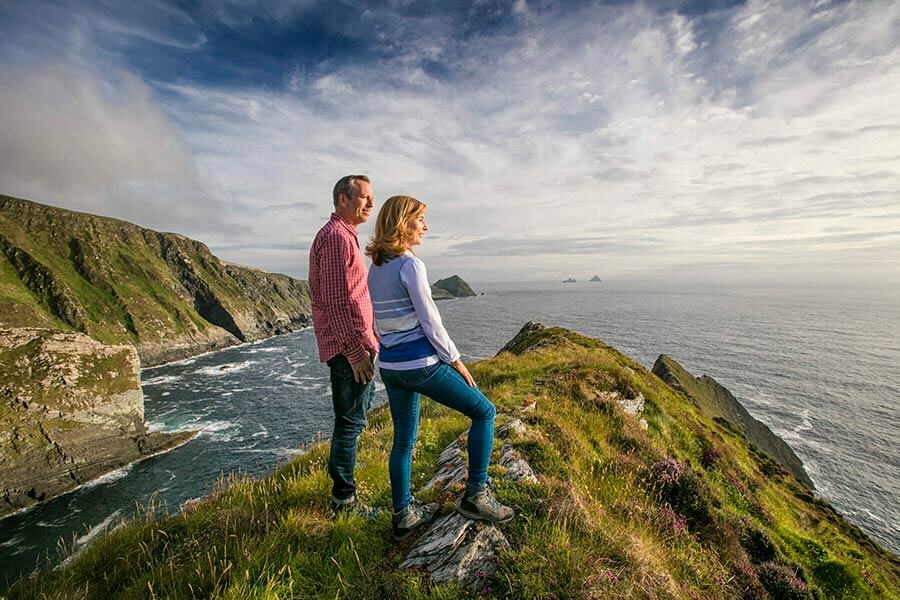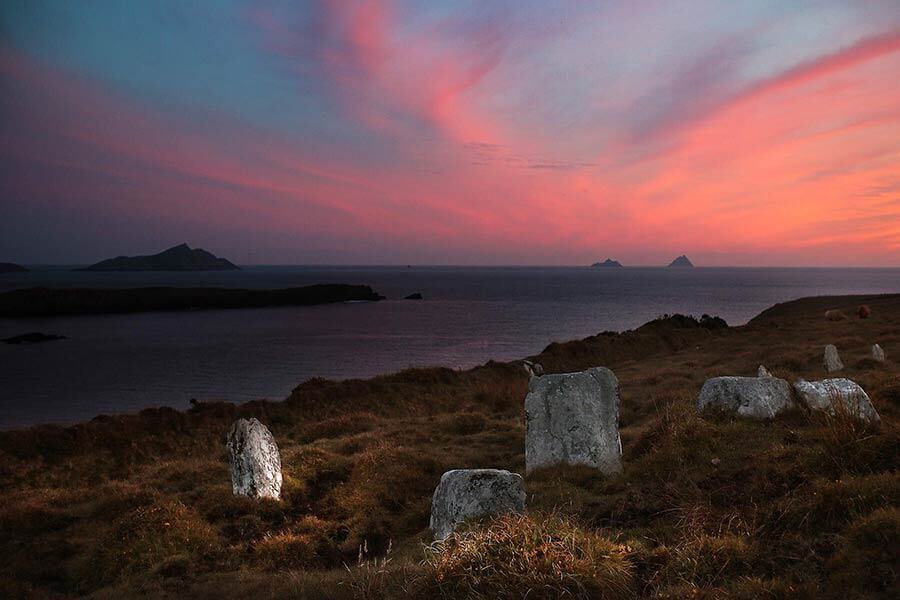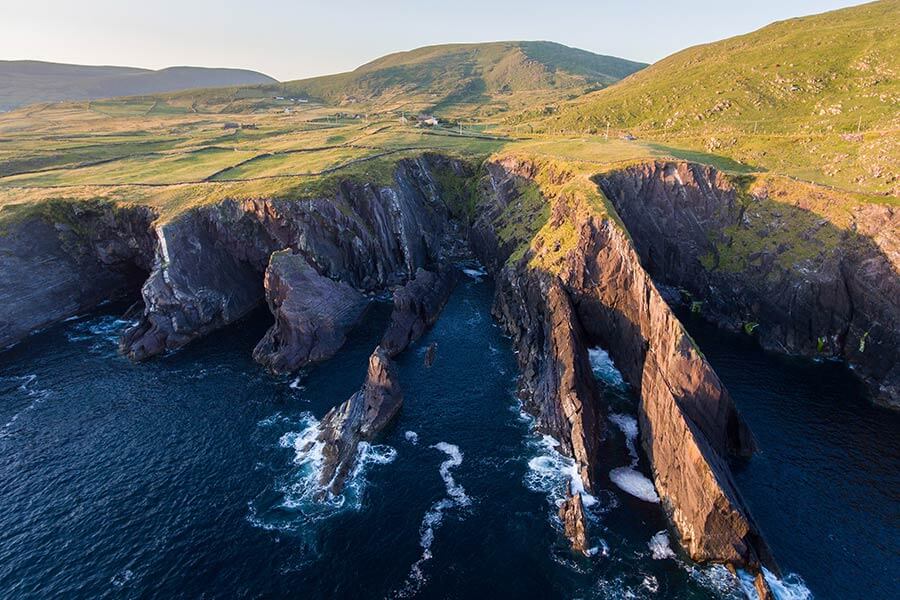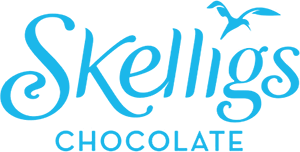The Skellig Coast Story
At the far west of the Iveragh Peninsula – half way round the famous Ring of Kerry – you feel like you’re standing on the edge of the world. This is the Skellig Coast.
Out to sea, two jagged crags – Oileáin na Scealaga – rise out of the Atlantic: Little Skellig, home to one of the largest seabird colonies in the world, and Skellig Michael, an extraordinary, far-flung place of pilgrimage – one of the wonders of the world.
The whole Skellig Coast is inspiring and energising. The coastal route, the Skellig Ring, takes you off down narrow lanes into the Gaeltacht (Irish-speaking region), through tiny ports and villages. You may find yourself climbing steep cliff roads, wind-buffeted above crashing seas. Or strolling along a wide sandy beach. In the distance, golden sunlight shines onto the rugged peaks of Iveragh and Dingle. The weather sweeps in off the Atlantic and through, followed by the widest of rainbows.
There’s a wide arc of history too, from the Tetrapod tracks on the shores of Valentia Island – the earliest fossil footprints in the world, to the nearby site of the first Transatlantic Cable, and from Daniel O’Connell’s birthplace at Cahersiveen and home at Derrynane National Park, to memories of Charlie Chaplin, who loved to holiday in Waterville.
You can really get to know people here. There are small family-run businesses: pubs with peat fires and traditional music sessions, bed and breakfasts, restaurants with rooms, and local food producers – from artisan chocolate to some of the best seafood in Ireland.
It’s surprisingly easy to be drawn off-the-beaten track, and lose yourself down byways. But if you do get lost – no matter. You’ll want to stay, take your time, and discover this place for yourself.



You’ll want to stop often at the many small settlements and towns along the route. Every few miles there are places to stretch your legs and have a bite to eat. Maybe you’ll hunker down and stay a night or two to get to know the places and the people … to climb cliffs, surf waves, ride bikes … to join in the craíc at sessions and festivals … to go island-hopping and visit ancient sites … to sit by turf fires in traditional pubs, where you’ll eat the freshest seafood and hear the Irish language, songs and stories. Out here in the west coast’s remote Gaeltacht regions, Irish is the mother tongue for many folk – and they’ll tell you “fáilte romhat isteach – you’re most welcome here”.
You could drive the whole route in one go – but you don’t have to. Instead, you may want to slow down, and dive in deep … For it’s out on these western extremities – drawn in by the constant rhythm of the ocean’s roar and the consistent warmth of the people – that you’ll find the Ireland you’ve always imagined.
A scenic drive along the Skellig Coast
Take in the sights of the stunning coastline and rolling countryside – incorporating Valentia Island, Portmagee, Coomanaspig Pass, and the beautiful beaches at St Finians Bay and Ballingskelligs.
At the far west of the Iveragh Peninsula – half way round the famous Ring of Kerry – you feel like you’re standing on the edge of the world. This is the Skellig Coast.
Out to sea, two jagged crags – Oileáin na Scealga – rise out of the Atlantic: Little Skellig, home to one of the largest seabird colonies in the world, and Skellig Michael, an extraordinary, far-flung place of pilgrimage – one of the wonders of the world.
The whole Skellig Coast is inspiring and energising. The coastal route, the Skellig Ring, takes you off down narrow lanes into the Gaeltacht (Irish-speaking region), through tiny ports and villages. You may find yourself climbing steep cliff roads, wind-buffeted above crashing seas. Or strolling along a wide sandy beach. In the distance, golden sunlight shines onto the rugged peaks of Iveragh and Dingle. The weather sweeps in off the Atlantic and through, followed by the widest of rainbows.
There’s a wide arc of history too, from the Tetrapod tracks on the shores of Valentia Island – the earliest fossil footprints in the world, to the nearby site of the first Transatlantic Cable, and from Daniel O’Connell’s birthplace at Cahersiveen and home at Derrynane National Park, to memories of Charlie Chaplin, who loved to holiday in Waterville.
You can really get to know people here. There are small family-run businesses: pubs with peat fires and traditional music sessions, bed and breakfasts, restaurants with rooms, and local food producers – from artisan chocolate to some of the best seafood in Ireland.
It’s surprisingly easy to be drawn off-the-beaten track, and lose yourself down byways. But if you do get lost – no matter. You’ll want to stay, take your time, and discover this place for yourself.
Try a taste of Heaven on the Skellig Coast
Halfway round the Iveragh Peninsula, narrow byways lead off the main Ring of Kerry towards Ballinskelligs. Signs change to Irish and 9 miles offshore two jagged crags – Oileáin na Scealaga – rise out of the Atlantic: Little Skellig, ghostly white, is home to one of the largest seabird colonies in the world, and Skellig Michael. The coastal route, the Skellig Ring, takes you along narrow lanes on clifftops dotted with sheep, with wild Atlantic waves crashing below. At St Finian’s Bay – down at the shoreline where the monks embarked en route for Skellig Michael – a very earthly pleasure awaits: a cup of hot chocolate at Europe’s most westerly chocolate factory. While surf crashes onto the tiny beach outside, you are enveloped in the warm smells of chocolate-making, inside ebullient Colm Healy’s family-run Skelligs Chocolate factory, at the edge of the world. Heavenly.


